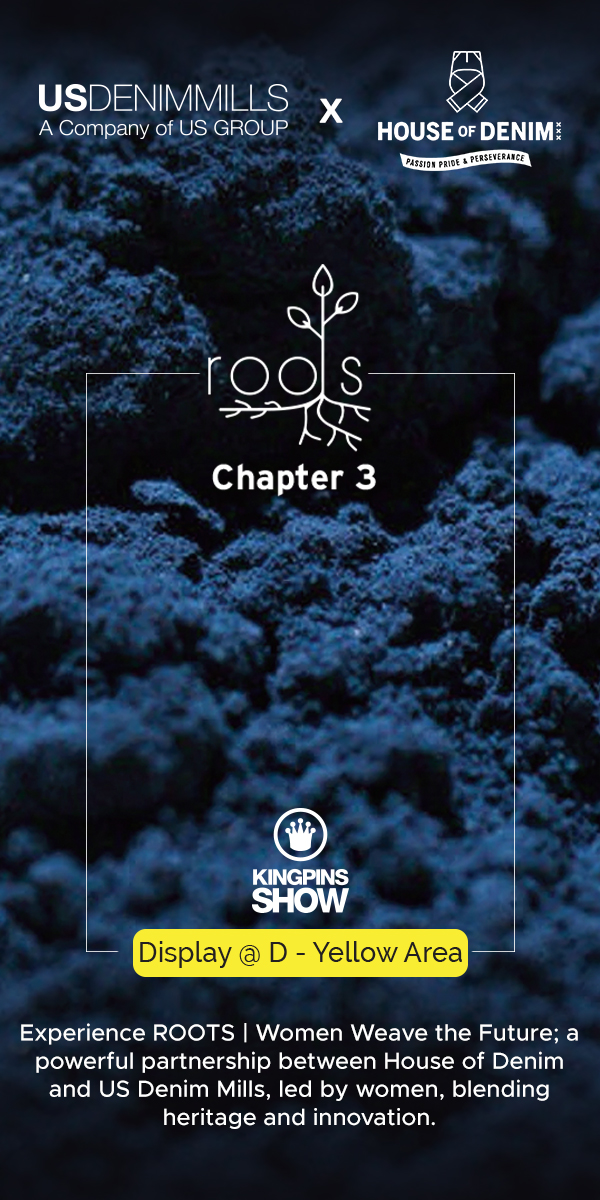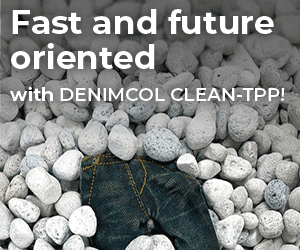From deckchairs to denim: UK selvedge stages a comeback

Hewitt Heritage Fabrics’ Lancashire-woven selvedge has been used in new ranges by brands including Hiut and Joe & Co, following a tough slog by its founder to set up production and develop the fabric to the right specifications. And while the volumes are far from those produced 30 years ago, these companies are part of a group of brands that place value on making jeans in Britain.
Chris Hewitt describes arriving outside a Lancashire mill as a moment that would change the course of his life. This might sound dramatic, but it marked a key moment in a long journey to produce UK-woven selvedge denim, and which has recently been selected for collections by brands including Hiut – whose co-founder describes him as a “denim maverick”. “Up until I spoke to Chris, I thought what we were doing was hard, but at least we still had a town full of grandmasters [experienced workers],” says David Hieatt. “When he told me, 10 years ago, that he was going to weave selvedge in Britain, I thought that would be a tough, tough ask.” With the domestic denim industry largely disappearing three decades ago, there is little in the way of infrastructure or support on the fabric side, but Mr Hewitt was determined to make it work. “My current mill likes a fighter,” he admits.
He set up Hewitt Heritage Fabrics in 2016, his love of denim and its heritage cemented through his vintage clothing shop, Somebody & Sons in London. The research stage for the selvedge involved several partners; finding those that could deliver proved problematic, not least because of the indigo. “Most British companies don’t weave a lot of yarn-dyed goods so they are reluctant to weave a fabric that might contaminate all their other products, especially if they are weaving on old looms,” Chris explains.
The breakthrough came when he discovered two 1950s Northrop shuttle looms that had been in retirement since weaving deckchair fabrics, and which could create the authentic look he was seeking. He returned to the mill time and again, testing for shrinkage and stability and hand feel. Finishing was a major challenge: “People would say, ‘yes, we can do that’, then they’d run 1,000 metres of fabric and it became clear they couldn’t, so I was left with fabric that’s very difficult to sell,” he says. “Hiut have been very encouraging in that they have stayed in the conversation for a very long time. Others do stay in, but most brands have built into their marketing the idea of a Japanese woven product."
Hiut, a jeansmaker and brand based in Cardigan, South Wales, was launched in 2011 following the closure of a former jeans factory in the town that had made 35,000 pairs per week. Owners David and Clare Hieatt wanted to protect those skills and create employment. Their slogan ‘Do one thing well’ and appealing marketing and ethos has earned fans that appreciate the high-quality fabric and attention to detail. The Hiut x Hewitt collection will be available in both men’s and women’s fittings and each will have a leather back-patch highlighting the journey between the two maker homes, Cardigan and Lancashire.
The Hewitt fabric is also being used by brands such as London-based United Overalls (see separate panel) and Joe & Co, a clothing company based in Manchester run by Josef Schindler, who reckons the British selvedge “can hold its own against any of the denim mills from Japan, the US or Italy”. He also highlights the heritage with an embroidered Lancashire red rose on the pocket, and is a vocal supporter of UK manufacturing. His collection launched in December, with the fabric travelling only 30 miles to be made into jeans, minimising the carbon footprint. “We made enquires into transporting the fabric using the Lancashire canal network,” says Mr Schindler “but this wasn’t a workable option.”
Indies and markets
Hewitt’s story is fairly pioneering when you consider there was never a vast amount of denim fabric made in the UK – even in its heyday most was imported and then made into jeans here. From the 1960s through to the early 90s, big brands such as Levi’s made in Britain but smaller independent labels also played a significant role. Different areas favoured different brands: Crazy Face, Joe Bloggs, Bleubolt, Boogie Jeans, Dollar Jeans and Road were among the brands of choice. They thrived because retail was not dominated by big groups; people also shopped in independent stores, boutiques and markets, around which the denim scene thrived.
Phil Wildbore, who owned the Road label, says the high street lowered the price of jeans. “In the late 80s and early 90s, it was normal to pay £40 for a pair of jeans, but that’s the same price that people want to pay now – they should be around £110 if we factor in inflation,” he says. “The demand for cheaper prices meant that you couldn’t compete. Then all the machinery got shipped abroad, so we lost all the infrastructure to make."
The closure of the highly regarded Smith & Nephew mill in Pendle in 1993 ended denim fabric production in England and was such a blow that it was discussed in parliament, with MP Gordon Prentice lamenting: “The decision might make commercial sense to one company but for the country as a whole it makes no sense.” Ireland’s Atlantic Mills, which also made denim fabric, closed in 1999.
Road, which was at one time producing 3,000 pairs of jeans per week from a family-run factory in Leicester, followed other brands in trying overseas manufacture. “It didn’t work; it didn’t have the same feel,” says Mr Wildbore. “The game had changed, it was more mass production. The jean world became incredibly generic."
Steady whirr of machines
There are a small number of jeansmakers in the UK, making for brands that value local manufacture. Blackburn-based clothing manufacturer Cookson & Clegg was founded in 1860, starting life as a boot upper supplier and now makes jeans for brands including Finisterre. Like many in the industry, it has had ups and downs: a year after being bought by designer Patrick Grant in 2015 it announced job losses following the loss of a big contract. It is now operating on a smaller scale, partly through Mr Grant’s Community Clothing social enterprise, which creates employment in the UK’s textile manufacturing regions.
Last summer, Cookson & Clegg won funding from Made Smarter, a programme helping small and medium-sized manufacturers implement new digital technologies. UK-based denim consultant Amanda Barnes says the company has a “top reputation” among UK producers. “On the denim side, it’s not so much about the authentic vintage machines (which many denim enthusiasts believe is key to a good pair of denim) but more about affordable quality at Community Clothing: a pair of raw organic 12.5oz selvedge are reasonably priced at £79.”
London-based Blackhorse Lane Ateliers is one of the more prominent UK jeansmakers, using beautiful fabrics from Japan, Turkey and Italy. The company is setting up a mini laundry this year which will help designers, students and brands develop wash techniques.
Brands that make jeans in the UK include Hove-based Dawson Denim, which uses Japanese fabrics sewn on 1950s sewing machines; Sheffield’s Forge Denim, which imports Japanese selvedge and uses steel buttons to represent the city’s steelmaking heritage; Fallow Denim, based in Brighton, which uses Japanese and Cone fabrics with deer leather patches tanned in Scotland; and HebTroCo from Hebden Bridge, which sources all its clothing and accessories in the UK. “Making in Britain is convenient, and minimums are lower,” says its co-founder, Brant Richards. “We truly value local production - all our manufacturing is within a drive of our unit - but we get cloth from Candiani because consistency of supply is crucial.”
On the fabric side, The London Cloth Company is a micro-mill that weaves small quantities to order and offers 60 types of indigo cloth, including a range with an indigo cotton warp and a Shetland wool weft.
Manufacturing revival?
With such a rich history of textiles and clothing making in the UK, could the sector be revived, particularly as people reconsider sourcing destinations? A report by The Alliance Project (TAP), initially in 2014 and updated in 2017, concluded there is potential in sectors such as homeware, luxury goods and fast fashion, and perhaps in value-added products like jacquard, embroidery and knitwear, but for staples the UK will remain uncompetitive on cost for some time. Decades of offshoring means there is a skills shortage and an ageing workforce, with major challenges including a predominantly micro-size supply chain with no OEMs, or large prime manufacturers, to act as “enablers”. “The UK also has one of the highest energy costs in any of our competitor markets,” said the report. TAP established two Regional Growth Funds using £27 million of public and £123 million of private money that it forecast would create over 4,000 jobs – however, the pandemic has hit the sector hard, as consumer spending dropped off and companies closed.
Chris Hewitt admits it’s difficult to have a successful clothing industry if the prices are not in line with the rest of Europe. “There are a lot of sewers here, but young people don’t want to go into that side of the industry, and it’s not something the government has an interest in developing,” he says. He is setting up a new brand this year, Somebody’s Denim, which will use the UK fabric (amongst others) with the jeans made in the UK and Portugal. “I’d love to be able to make everything here but it’s so hard to remain competitive,” he explains.
Even if the numbers work, the UK doesn’t currently have the infrastructure to support a denim industry at scale. Denim consultant and the co-founder of The Three Indigos Idrish Munshi, whose family owned a laundry in Leicester in the 80s and 90s, says strict water rules and the cleaning cost of effluent are too prohibitive. “In the past, when Levi's and Wrangler were made in the UK, washing here was worthwhile because companies understood the water challenges and would pay a decent rate. When other companies realised ways of bypassing the water rules or they installed their own effluent treatment plants, they reduced the costs of processing the garments and it was difficult to compete. Today, it would be difficult to restart this side of the industry here using conventional means - the effluent treatment plant would make it too costly. Sustainable processing using modern technologies could be a feasible option."
Common practice
That’s not to say there is not a thriving denim scene in the UK: there are plenty of passionate designers, creatives, consultants, retailers and fans; people working within global companies, or brands or retailers that make offshore, as well as those making collections domestically. While mass-market denim looks unlikely to return, it seems there could be the desire and potential for more niche makers.
For Hewitt, the target is to develop a yarn and dye it locally (yarns are currently brought in from Turkey) and eventually create a compostable jean. For Hiut, using British selvedge represents a wider ideal of keeping alive the opportunity of manufacturing for future generations. “People don’t understand how hard it is to do what Chris did,” says David Hieatt. “It’s the stuff we dreamt about when we started, that we’d do a fully British jean. People congratulate us on our success, but success isn’t being the only one, it is when the infrastructure comes back and making denim in Britain becomes a lot easier. We’d like it to be common practice to have denim woven in the UK – it’s good for the environment, for industry and skills. This is a key defining moment, but it should only be the start.”
Image credit: Hewitt Heritage Fabrics
A perfect fit for United Overalls
Thomas Burke, founder of the London-based brand, uses Hewitt’s fabric for five-pocket jeans made at Blackhorse Lane Ateliers.
What’s important to you about sourcing fabrics from, and manufacturing in, the UK?
It was always a crucial part of our brand that we source as much as we could from the UK. Making the highest quality jeans also meant that the denim we used had to be a selvedge denim woven in the UK, which was only being made by Hewitt Heritage Fabrics. They upheld a lot of the ideals and standards that we wanted to, seeking the most ethical and sustainable practices.
When we were searching for a manufacturer, we were already friendly with the founder of Blackhorse Lane Ateliers, Han Ates, after attending their first opening party back when it was an empty industrial building. They strive to make everything as sustainable as possible and they work with their local community so they can give back as much as possible.
How do you think the fabric compares with Japanese denim?
The yarns are not as exciting as some that you might find coming out of Japan but for someone looking for a vintage style finish and fading process the denim from Hewitt Heritage is great. The character and nuances that the 1950s Northrop looms add to the fabric become much more apparent after wear and conjure up images of the jeans made in early 20th Century America.
Would you buy more UK fabric if it were available?
If more mills started up in the UK making more selvedge denim then we would be overjoyed, the more manufacturing that we bring back to the UK the better! Most of our customers see UK-made denim as a very new idea but are excited to purchase such a unique item. They can really feel the quality in what we make and that is due in a large part to the amazing denim we receive.












